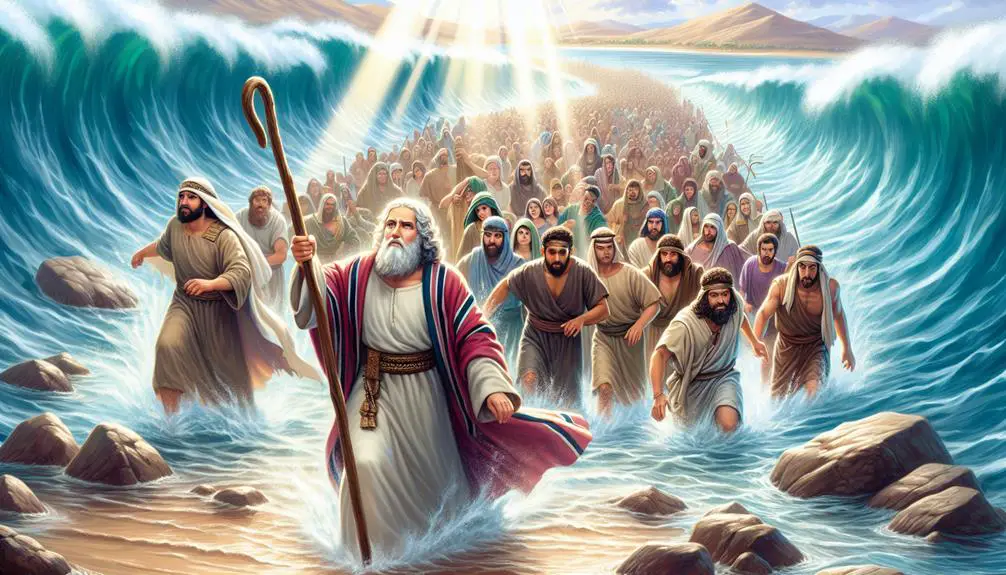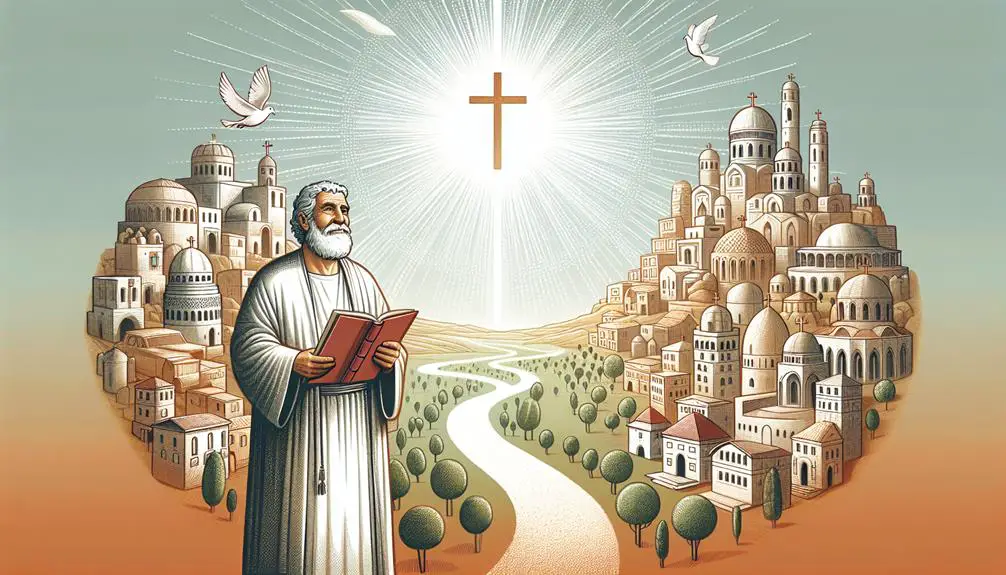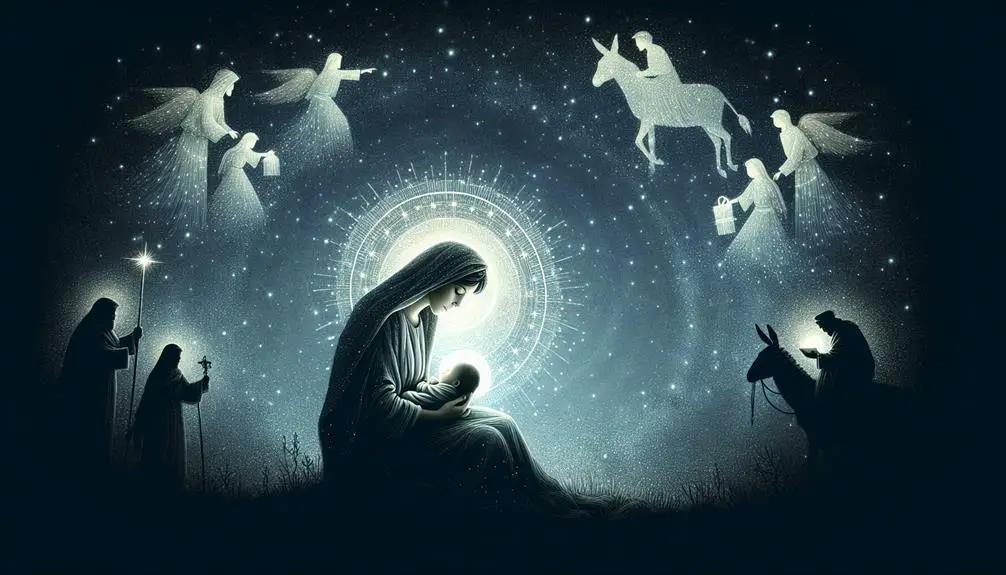Kings, prophets, and apostles: uncover the pivotal roles of Bible figures and the timeless lessons they impart.

Prominent Figures in the Bible
The Bible, a cornerstone of religious thought and moral guidance for billions, presents a tapestry of figures whose lives and legacies have shaped not only the course of religious history but also the fabric of human culture.
From Adam, representing humanity's genesis and inherent challenges, to Mary, embodying unconditional obedience and faith, these characters offer profound insights into virtues, vices, and the human condition.
As we explore the narratives of individuals such as Moses, David, Solomon, Esther, and Paul, we uncover layers of wisdom and moral dilemmas that continue to resonate in today's complex world.
Their stories, rich with thematic depth and ethical quandaries, invite a closer examination of the values and beliefs that have influenced countless generations.
Key Takeaways
- Biblical protagonists like Moses and David illustrate themes of faith, leadership, and divine intervention.
- Figures such as Solomon and Esther demonstrate the importance of wisdom, bravery, and legacy in biblical narratives.
- Divine encounters, like Moses receiving the Ten Commandments, play crucial roles in establishing moral and legal frameworks.
- The historical impact and religious practices surrounding these figures continue to influence Christianity and Western culture.
Adam: Humanity's Genesis

Adam, often recognized as the progenitor of the human race, occupies a foundational role in the biblical narrative, symbolizing humanity's genesis within the Judeo-Christian tradition. The account of Adam, as detailed in the Book of Genesis, not only introduces the figure as the first man but also sets the stage for a profound theological discourse on the nature of human fallibility through the concept of Original Sin. This concept is intrinsically linked to Adam's actions within the Garden of Eden, a paradisiacal realm from which humanity's earliest ancestors were expelled.
The narrative surrounding Adam and the Garden of Eden carries significant theological weight, serving as a critical juncture where free will, temptation, and disobedience converge, resulting in the fall from grace. The Genesis account vividly depicts the temptation of Adam and Eve by the serpent, leading to their consumption of the forbidden fruit. This act of defiance against divine commandment is pivotal, marking the inception of Original Sin and delineating a fundamental aspect of human nature as viewed through the lens of Judeo-Christian thought.
The repercussions of this disobedience are far-reaching, not only affecting Adam and Eve but also setting a precedent for the human condition. The concept of Original Sin, as derived from this narrative, posits a hereditary moral flaw embedded within humanity, necessitating divine intervention for redemption. Thus, the story of Adam in the Garden of Eden encapsulates key theological themes such as temptation, sin, and the perpetual human struggle for moral integrity, framing the subsequent narrative arc of redemption and salvation within the biblical corpus.
Moses: Liberator of Israel

Moses, a seminal figure in Abrahamic religions, embodies the complex interplay of divinity and leadership in the liberation of the Israelites from Egyptian bondage.
His early life in Egypt, marked by an unusual adoption into Pharaoh's household, sets the stage for a profound transformation from a prince to a prophet leading the Exodus.
This journey, underscored by the reception of the Ten Commandments, not only redefines Israelite law and society but also cements Moses' legacy as a pivotal liberator and lawgiver.
Early Life in Egypt
Born into a Hebrew family during a time of intense persecution, the early life of Moses in Egypt is marked by divine intervention and a series of providential events that set the stage for his future role as the liberator of Israel. Amid the backdrop of pyramid construction and the cyclical Nile flooding, which were central to Egyptian civilization's economy and culture, Moses' story begins.
His birth coincides with a decree from the Pharaoh to kill all newborn Hebrew boys, a reflection of the Egyptians' fear of the growing Hebrew population. This period of Moses' life underscores the harsh realities of slavery and the Hebrews' desperate desire for liberation. Despite these adversities, Moses' survival and upbringing in the Egyptian royal court were instrumental in preparing him for his eventual mission.
The Exodus Journey
The Exodus journey, a pivotal event in the biblical narrative, marks the transition of the Israelites from slavery in Egypt to their quest for freedom under the leadership of Moses. This period is characterized by significant events and challenges, including:
- The Plagues of Egypt: Demonstrating divine intervention in liberating the Israelites.
- The Parting of the Red Sea: Symbolizing the final escape from Pharaoh's grasp and the beginning of freedom.
- Wilderness Wanderings: A time of testing, faith-building, and reliance on divine provision for survival.
- Miriam's Leadership: Her role was crucial in maintaining the spiritual and communal unity among the Israelites, especially during times of despair and conflict.
These elements collectively underscore the complexity and significance of the Exodus journey, highlighting themes of faith, leadership, and divine intervention.
Ten Commandments Received
Amidst their nomadic journey through the desert, the Israelites received the Ten Commandments, a foundational set of divine laws, through Moses at Mount Sinai, marking a covenantal moment that would define their identity and ethical standards for millennia. The event at Mount Sinai is pivotal, underscoring the covenant significance between God and His chosen people. This moment not only shaped the moral compass of the Israelites but also established a legal and ethical framework that has influenced Western legal systems and moral philosophy.
Mount Sinai |
Covenant Significance |
Impact |
|---|---|---|
Divine Encounter |
God's Pact with Israel |
Ethical Standards |
Revelation |
Identity Formation |
Legal Framework |
Moral Compass |
Ethical Norms |
Societal Influence |
Theophany |
Binding Agreement |
Cultural Legacy |
David: A King's Heart

Transitioning from the narrative of Moses, a liberator, to that of David, a king, invites a nuanced exploration of leadership in biblical contexts.
David's ascent from pastoral obscurity to defeating Goliath underscores a theme of divine favor and moral fortitude.
This juxtaposition not only reflects the complexity of his character but also sets the stage for discussing the multifaceted nature of his kingship.
David's Humble Beginnings
David's ascent from shepherd boy to the king of Israel embodies the quintessential tale of humble beginnings leading to extraordinary destinies. His early life, marked by pastoral simplicity, laid the foundation for a journey that would forever alter the course of biblical history.
Before his pivotal Goliath encounter, David's existence was characterized by:
- Tending to Sheep: An emblem of his humility and responsibility.
- Musical Prowess: A skill that provided solace to King Saul.
- Spiritual Devotion: An unwavering faith that guided his actions.
- Anointment by Samuel: A prophetic act signifying his future kingship.
This phase of David's life, devoid of royal trappings, was instrumental in shaping the virtues that would define his reign—courage, leadership, and a heart attuned to divine will.
Triumph Over Goliath
In the annals of biblical narratives, David's victory over Goliath stands as a watershed moment that not only solidified his future kingship but also exemplified the triumph of faith and courage over seemingly insurmountable odds. The shepherd's courage in facing the giant from the Philistine army encapsulates the essence of divine providence aligning with human valor. This historical event is not merely a tale of physical conquest but a profound lesson on the power of belief and the potential within the ostensibly weak.
Aspect |
Significance |
|---|---|
Shepherd Boy |
Symbol of innocence, faith, and potential |
Goliath |
Representation of insurmountable challenges |
Victory |
Triumph of faith and courage |
Analyzing this victory, it's clear that narratives of such depth serve multiple interpretive purposes, showcasing the multifaceted nature of biblical stories.
Solomon: Wisdom and Wealth

Solomon, the biblical monarch renowned for his wisdom and opulence, epitomizes the zenith of Israel's power and prosperity in ancient scriptural narratives. His reign is often depicted as a golden era, marked by unprecedented peace and wealth. Central to his legacy are two significant events: the visit from the Queen of Sheba and the construction of the Temple in Jerusalem. These events not only highlight Solomon's wisdom and wealth but also demonstrate his influence and the extent of his kingdom.
- The Visit from the Queen of Sheba: This event underscores Solomon's international reputation for wisdom. The Queen of Sheba, intrigued by reports of Solomon's unparalleled wisdom, traveled to Jerusalem with a grand entourage to test this wisdom with challenging questions. Solomon's insightful answers and the splendor of his court left her in awe, symbolizing his global stature and intellect.
- Temple Construction: Solomon's most enduring legacy is perhaps the construction of the Temple in Jerusalem, a monumental project that took seven years to complete. This edifice symbolized not only the religious centrality of Jerusalem but also Solomon's commitment to Yahweh. It was adorned with the finest materials, underscoring the wealth of Solomon's reign.
- Wealth Accumulation: Solomon's wealth was legendary, with gold and precious materials flowing into his kingdom from distant lands. This wealth enabled him to undertake large-scale projects and provided the economic stability that marked his reign.
- Administrative Wisdom: Solomon's governance, characterized by the division of the kingdom into administrative districts, showcased his strategic wisdom in managing the complexities of a burgeoning empire.
In analyzing Solomon's reign, one observes a figure who embodies the complexities of leadership, marked by both wisdom and challenges. His story offers a nuanced insight into the dynamics of power and the pursuit of prosperity and peace.
Esther: Bravery Embodied

Esther's narrative in the Hebrew Bible exemplifies unparalleled bravery and strategic intellect, as she navigates complex political landscapes to save her people from extermination. This tale, deeply embedded in Jewish tradition, not only recounts a story of survival and cunning but also serves as the foundational reason for the Purim celebration. It underscores the triumph of a marginalized community against a plot of mass genocide, orchestrated by royal intrigue and the abuse of power.
The story of Esther unfolds in the Persian Empire, where she rises from obscurity to become queen. However, her narrative is not merely one of royalty and privilege. Instead, it is marked by her audacious decision to risk her own life by revealing her Jewish identity to King Ahasuerus, in an effort to thwart the genocidal decree against her people, masterminded by the king's vizier, Haman. This act of bravery is not impulsive but is a calculated risk, showcasing Esther's profound understanding of the intricacies of royal intrigue and her strategic maneuvering within it.
Esther's story is a powerful testament to the strength of individual agency in the face of systemic oppression. Her actions demonstrate a keen intellect and a willingness to use her position of influence for the greater good, even when it means facing potential personal peril. The Purim celebration commemorates this victory, highlighting Esther's role as a savior of her people and celebrating the resilience and solidarity of the Jewish community against attempts at their destruction. Through her story, Esther remains a symbol of courage and strategic brilliance, embodying the very essence of bravery.
Paul: Apostle of the Gentiles

Shifting focus from the narrative of Esther, another pivotal figure emerges in the biblical panorama: Paul, known as the Apostle of the Gentiles, whose contributions to Christianity are foundational and transformative. Initially known as Saul of Tarsus, his conversion on the road to Damascus represents a watershed moment not only in his life but in the history of Christian thought and practice. This event catalyzed his transition from a persecutor of Christians to a fervent apostle of Jesus Christ, dedicated to spreading the Christian faith among Gentiles.
Paul's contributions are manifold, but four aspects stand out as particularly significant:
- Paul's Conversion: A dramatic encounter with the risen Christ led to his transformation. This event underscores the power of personal revelation and the potential for change in the human spirit.
- Missionary Journeys: Paul embarked on several missionary journeys across the Mediterranean, establishing Christian communities in key cities. These endeavors facilitated the spread of Christianity beyond its Jewish roots into a broader cultural context.
- Epistles: Paul's letters to the early Christian communities are among the earliest Christian documents we possess. They articulate key theological concepts and ethical guidelines that continue to influence Christian thought and practice.
- Advocate for Gentile Christians: Paul argued vehemently against the necessity of circumcision for Gentile converts, thus broadening the scope of Christian inclusivity. His vision of a faith accessible to all, regardless of ethnic background, was revolutionary.
Analyzing Paul's life and work reveals a figure of immense complexity and profound influence. His missionary zeal and theological insights helped shape the nascent Christian movement into a faith that would encompass the globe.
Mary: Mother of Jesus

ARTICLE TITLE: Figures in the Bible
PREVIOUS SUBTOPIC: 'Paul: Apostle of the Gentiles'
CURRENT SUBTOPIC: 'Mary: Mother of Jesus'
Among the most revered figures in Christianity, Mary, the Mother of Jesus, stands as a symbol of grace, obedience, and faithfulness, embodying the maternal archetype in Christian theology. Her significance is multifaceted, extending beyond her biblical narrative to influence theology, art, and devotion within the Christian tradition. Central to her veneration are the doctrines of the Immaculate Conception and the Assumption into Heaven, which underscore her purity and her pivotal role in the Christian story of salvation.
Concept |
Description |
|---|---|
Immaculate Conception |
The belief that Mary was conceived free from original sin, highlighting her unique sanctity. |
Assumption into Heaven |
The doctrine stating that Mary was taken bodily into Heaven at the end of her earthly life. |
These doctrines, while not explicitly detailed in the Scriptures, have been deduced from the narrative arc of Mary's life as depicted in the Bible and have been affirmed by theological scholarship and ecclesiastical authority through the centuries. The Immaculate Conception, declared dogma in 1854 by Pope Pius IX, emphasizes Mary's predestined purity and grace as the mother of Jesus Christ. The Assumption, recognized as dogma in 1950 by Pope Pius XII, symbolizes her completion of earthly life and her elevation to eternal glory, reinforcing her role as a figure of hope and intercession for the faithful. Mary's story, interwoven with themes of divine grace and human obedience, continues to inspire a deep and complex devotion among Christians worldwide, reflecting her enduring legacy as the Mother of God.
Frequently Asked Questions
How Do the Archaeological Records Align With the Timelines and Events Described for Each of These Biblical Figures?
Archaeological records, when analyzed through advanced dating techniques and geographic correlation, offer a complex perspective on the alignment with historical timelines and events.
The precision of these methods allows for a nuanced understanding of past occurrences, providing evidence that may either corroborate or challenge traditional narratives.
While the evidence can be compelling, it's crucial to note that archaeological interpretations are continually evolving as new discoveries emerge and methodologies improve.
In What Ways Have Modern Interpretations and Understandings of These Figures' Stories Evolved From Traditional Views?
Modern interpretations of historical narratives have evolved significantly. This evolution is marked by gender interpretations, offering new insights into roles and representations, and ethical reevaluations, challenging previously accepted moral judgments. Such scholarly inquiry, informed by contemporary values and understanding, has led to a nuanced appreciation of these stories. It moves beyond traditional views to embrace a more inclusive and critical perspective.
How Do Non-Abrahamic Religions and Secular Historical Texts View or Reference These Biblical Figures, if at All?
Exploring the perspectives of non-Abrahamic religions and secular historical texts on these figures necessitates a deep dive into comparative mythology and iconographic analysis. This scholarly approach uncovers a rich tapestry of interpretations, where these characters are often paralleled with mythological figures from diverse traditions, suggesting universal archetypes.
Secular texts, through a critical lens, may offer insights into the historical and cultural contexts that shaped these narratives, providing a nuanced understanding of their significance across cultures.
What Are the Most Significant Controversies or Debates Among Scholars Regarding the Historical Accuracy of the Accounts of These Figures?
In the realm of historical analysis, a bone of contention among scholars centers on the veracity of certain accounts, particularly regarding genealogy discrepancies and skepticism surrounding reported miracles. This scrutiny reflects a broader debate over the reliability of ancient texts.
Researchers apply a rigorous, analytical lens, assessing the congruity of records and the plausibility of supernatural claims, thereby navigating the complex terrain between historical fact and narrative embellishment.
How Have the Legacies of These Biblical Figures Been Represented or Utilized in Contemporary Politics, Social Movements, or Cultural Debates?
In contemporary discourse, the legacies of historical figures are often represented through artistic representations and leveraged to draw ethical parallels within politics, social movements, and cultural debates. These portrayals serve not only as a means of cultural expression but also as tools for ideological and moral argumentation.
The utilization of such legacies underscores the enduring influence of historical narratives in shaping contemporary values and societal norms, fostering a bridge between past and present ethical frameworks.
Conclusion
In conclusion, the examination of these prominent biblical figures reveals not only the foundational narratives of Abrahamic faiths but also offers insights into the complexities of human nature, leadership, wisdom, and sacrifice.
Through the lens of historical and theological analysis, one discerns the multifaceted impact of these individuals on religious thought, cultural ethos, and moral frameworks.
This exploration invites further scholarly inquiry into the veracity and implications of their stories, challenging readers to consider the deeper truths embedded within these ancient texts.



Sign up